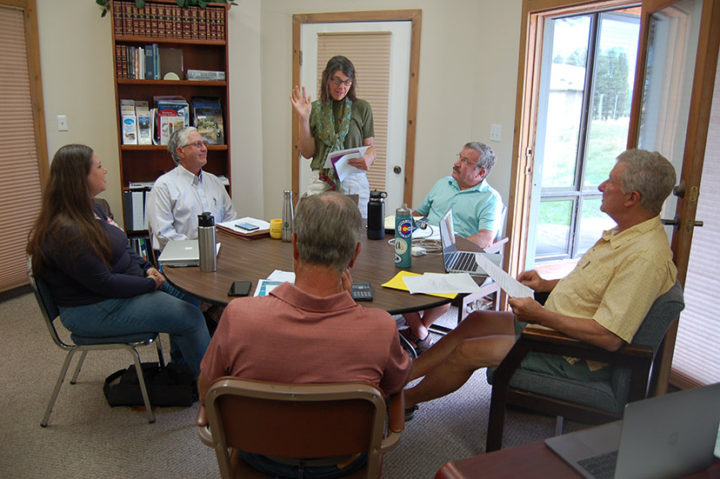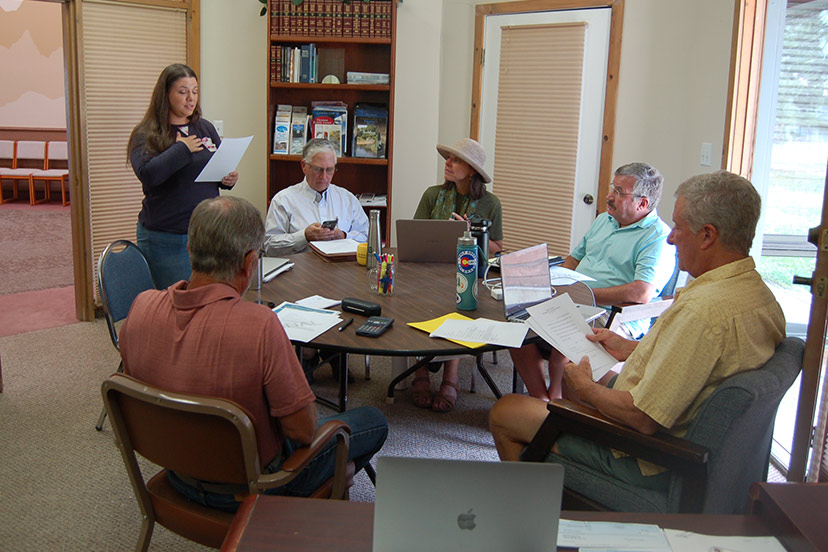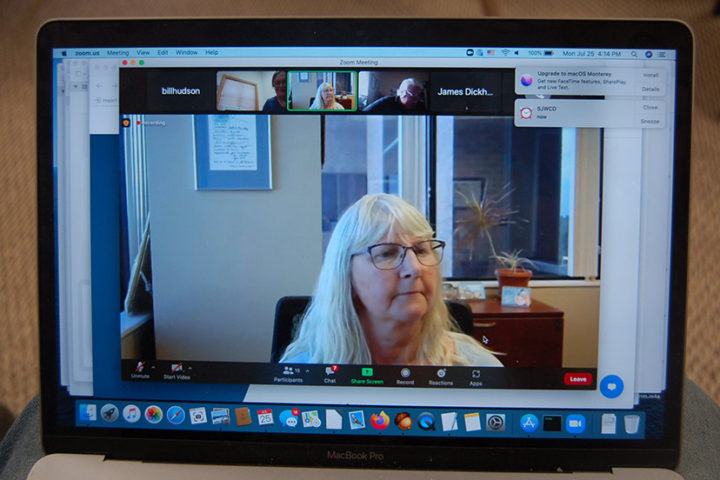PHOTO ABOVE: Rachel Suh recites her oath of office at the July 25 San Juan Water Conservancy District meeting.
The board of the San Juan Water Conservancy District (SJWCD) held its July meeting last night, July 25, and the festivities included the ‘swearing in’ of new board members Rachel Suh, Candace Jones, Bill Nobles and Rod Proffitt. The new board members promised to abide by the U.S. and Colorado Constitutions and fulfill their volunteer duties, to the best of their ability. (Mr. Proffitt attended the meeting via Zoom, due to COVID.)

These new members join existing board members Susan Nossaman, Doug Secrist, Joe Tedder, and Al Pfister. As a court-appointed committee (no, you didn’t get a chance to elect these folks) the eight-member board will be working to implement the recently-developed “SJWCD Strategic Plan” and looking at the best ways to spend the District’s $90,000 in annual tax receipts.
You can download the Strategic Plan here. The board is currently working on an update to the plan.
Last week, we concluded Part One of this editorial series with the following comments, referring to the reputation of the San Juan Water Conservancy District (SJWCD):
I would tend to agree with [new SJWCD board member Rachel Suh], that the general impression of the Conservancy District, among the taxpaying public, has tended to be “negative”.
Except… I might propose that most of the taxpaying public doesn’t even know the District exists.
And those who do know that it exists, might well be wondering why it exists.
The District will be making an effort, this summer, to become more visible, and let the taxpayers know why they exist. They’ve planned to host an informational booth, for example, at the Archuleta County Fair (Thursday August 4 through Sunday, August 7).
One important discussion at last night’s board meeting involved a new ‘water demand’ analysis submitted by the water engineers at Wilson Water Group (WWG). The presentation of the report was delivered by Erin Wilson, via Zoom.
Back when I was still serving on the SJWCD Board, I had some conversations with WWG, explaining to them that (in my opinion) they had used inaccurate data in a previous 2021 water demand report they had written for SJWCD. WWG decided not to correct the data.
Unfortunately for Archuleta County taxpayers, WWG continued to use the same inaccurate data in their 2022 analysis.
SJWCD paid $15,000 for the report. (That is to say, the taxpayers paid $15,000.) Maybe, for that price, accurate data is too much to expect?
SJWCD was formed in 1987 — when the population of Archuleta County was just beginning to explode with incoming retirees and second-home owners looking for a suburban paradise in the mountains. As a result of that explosion (an annual population growth rate of 8.5% between 1990 and 2000) two key industries expanded rapidly: home construction and real estate. SJWCD was (purportedly) formed to ensure that the community had enough water rights and water storage to serve its growing population.
As things played out, however, the push to create additional water storage became tainted by corrupt SJWCD leadership, as we’ve documented here in the Daily Post.
One result of that corrupt leadership was a $10 million debt that Pagosa Area Water and Sanitation District (PAWSD) customers are paying off, little by little, resulting from the purchase of the Running Iron Ranch in 2008.
Disclosure: I currently serve on the Pagosa Area Water and Sanitation District (PAWSD) board of directors, but this editorial reflects only my own personal opinions, and not necessarily those the PAWSD board as a whole.
None of the current SJWCD board members were involved in the purchase of the Running Iron Ranch, but SJWCD is nevertheless contractually bound — in a contract with Colorado Water Conservation Board — to try and get the Dry Gulch Reservoir built. Starting in 2010, the SJWCD board had been assuming that the reservoir size should match the decreed water rights: 11,000 acre feet. Roughly six times the size of our existing Hatcher Reservoir.
The water would be sucked out of the San Juan River.
To put 11,000 acre feet into perspective, PAWSD sold about 1,350 acre feet of treated water last year (2021). So, in theory, an 11,000 acre foot reservoir would hold enough water to serve the entire PAWSD service area for over eight years, even if not a single drop of rain or flake of snow fell during those eight years.
Maybe a smaller reservoir makes more sense?
That was the central question posed to the Wilson Water Group. We didn’t get a definite answer, however, in their ‘Water Demand’ analysis. In fact, what we got might be merely more controversy?
(You can download the report here.)
Nearly half of the Wilson Water Group analysis focused on “E&R” water demands.
“Environmental & Recreational” demands.
Since the 1960s, Americans have been gradually accepting the fact that the Environment can be treated as a thing of value, and that humans — if they care about sustaining life on the planet — probably shouldn’t completely drain the rivers.
The Environment itself doesn’t make demands, of course. It only lets us know, afterwards, that we’ve fouled our nest. So the state of Colorado has implemented laws about the use of water, recognizing that rivers remain healthier (and the Environment remains healthier) if we don’t try to over-engineer Nature…
…as was suggested by the quote from Andy Mueller, Director of the Colorado River District… quoted in the Denver Post yesterday, July 25:
We thought we could engineer nature. Huge mistake.
The Upper San Juan Watershed Enhancement Partnership, more affectionately know as “the WEP”, published a study last year of the upper San Juan River watershed, to try and quantify how much water really ought to flow through downtown Pagosa Springs, if we want a healthy river that is also a great place to recreate.
The other half of “E&R” demands is, of course, “Recreation”. And maybe this is where the bigger controversy happens?


